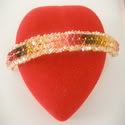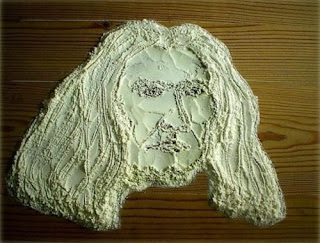This is the George Washington Bridge. You can find this bridge between the border of New Jersey and New York. Aside from that, for me it is a mark that a long drive of over 11 hours from Michigan to New York is over. Our last trip was February 12, before Valentines day. On this trip it is quite different because when we reached the bridge as you can see in the picture, there is a build up of traffic, so I got my camera and took some pictures. After many times of going back and forth from Michigan to New York, I always tried to take a picture, fortunately this time I had the chance.
Groundbreaking for the new bridge began in October 1927, a project of the
Port of New York Authority. Its chief engineer was
Othmar Ammann, with
Cass Gilbert as architect. The bridge was dedicated on
October 24,
1931, and opened to traffic the following day. Initially named the "Hudson River Bridge," the bridge is named in honor of
George Washington, the first
President of the United States. The Bridge is near the sites of
Fort Washington (on the New York side) and Fort Lee (in New Jersey), which were fortified positions used by General Washington and his American forces in his unsuccessful attempt to deter the
British occupation of New York City in 1776 during the
American Revolutionary War. Washington evacuated
Manhattan by crossing between the two forts. In 1910 the Washington Chapter of the
Daughters of the American Revolution erected a stone monument to the
Battle of Fort Washington. The monument is located about 100 yards (91 m) northeast of the
Little Red Lighthouse, up the hill towards the eastern bridge anchorage.When it opened, the bridge had the
longest main span in the world; at 1,067 m (3,500 ft), it nearly doubled the previous record of 564 m (1,850 ft), which had been held by the
Ambassador Bridge. (The record has since been exceeded
numerous times.) The total length of the bridge is 1,451 m (4,760 ft).
As originally built, the bridge offered six lanes of traffic, but in 1946, two additional lanes were provided on what is now the upper level. A second, lower deck, which had been anticipated in
Ammann's original plans, was added, opening to the public on
August 29,
1962. This lower level has been waggishly nicknamed "
Martha."
[8] The additional deck increased the capacity of the bridge by 75 percent, making the George Washington Bridge the world's only 14-lane suspension bridge, providing eight lanes on the upper level and six on the lower deck.
The original design for the towers of the bridge called for them to be encased in concrete and granite. However, due to cost considerations during the
Great Depression and favorable aesthetic critiques of the bare steel towers, this was never done. The exposed steel towers, with their distinctive
criss-crossed bracing, have become one of the bridge's most identifiable characteristics.
Le Corbusier (Charles-Edouard
Jeanneret) said of the unadorned steel structure:
The George Washington Bridge over the Hudson is the most beautiful bridge in the world. Made of cables and steel beams, it gleams in the sky like a reversed arch. It is blessed. It is the only seat of grace in the disordered city. It is painted an aluminum color and, between water and sky, you see nothing but the bent cord supported by two steel towers. When your car moves up the ramp the two towers rise so high that it brings you happiness; their structure is so pure, so resolute, so regular that here, finally, steel architecture seems to laugh. The car reaches an unexpectedly wide apron; the second tower is very far away; innumerable vertical cables, gleaming against the sky, are suspended from the magisterial curve which swings down and then up. The rose-colored towers of New York appear, a vision whose harshness is mitigated by distance." (When the Cathedrals were White, 1947.)














































 while afterwards my husband and his friend continued shopping for a Vacuum. And aside from that I bought some stuff also.
while afterwards my husband and his friend continued shopping for a Vacuum. And aside from that I bought some stuff also.





.jpg)
.jpg)
.jpg)
.jpg)
.jpg)
.jpg)
.jpg)
.jpg)
.jpg)
.jpg)



































